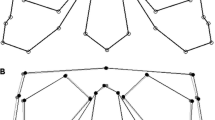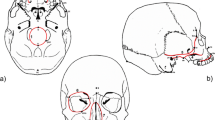Abstract
The aim of this paper is to investigate ageing changes in craniofacial region in both sexes and evaluate whether these shape changes are substantial to achieve age discrimination of samples used in anthropological analyses. The study sample consisted of 157 crania of known sex and age (81 males and 76 females) belonging to individuals who lived in Greece during the twentieth century. The sample was divided in three age groups: young adults (YA, 18–39 years old), middle adults (MA, 40–59 years old) and old adults (OA, >60 years old). The three-dimensional coordinates of 31 ecto-cranial landmarks were digitized using a Microscribe 3DX contact digitizer, and landmark configurations were analyzed using the generalized least-squares Procrustes method. The results indicate that both males and females show significant difference among the age groups; however, shape differences can not be used for age group discrimination due to a large range on the accuracy of age group classification. The morphometric changes related to age were different between sexes.



Similar content being viewed by others
References
Boskey AL, Coleman R (2010) Aging and bone. J Dent Res 89(12):1333–1348
Pessa JE, Chen Y (2002) Curve analysis of the aging orbital aperture. Plast Reconstr Surg 109(2):751–755
Shaw RBJ, Kahn DM (2007) Aging of the midface bony elements: a three-dimensional computed tomographic study. Plast Reconstr Surg 119(2):675–681
Coleman SR, Grover R (2006) The anatomy of the aging face: volume loss and changes in 3-dimensional topography. Aesthet Surg J 26(1):S4–S9
Enlow DH (1968) The human face: an account of the postnatal growth and development of the craniofacial skeleton. Hoeber, New York
Bartlett SP, Grossman RG, Whitaker LA (1992) Age-related changes of the craniofacial skeletal: an anthropomorphic and histologic analysis. Arch Facial Plast Surg 90:592
Pessa JE, Zadoo VP, Yuan C, Ayedelotte JD, Cuellar FJ, Cochran CS, Mutimer KL, Garza JR (1999) Concertina effect and facial aging: nonlinear aspects of youthfulness and skeletal remodeling, and why, perhaps, infants have jowls. Plast Reconstr Surg 103(2):635–644
Pessa JE (2000) An algorithm of facial aging: verification of Lambros Õs theory by three-dimensional stereolithography, with reference to the pathogenesis of midfacial aging, scleral show, and the lateral suborbital trough deformity. Plast Reconstr Surg 106:479–488
Zadoo VP, Pessa JE (2000) Biological arches and changes to the curvilinear form of the aging maxilla. Plast Reconstr Surg 106(2):460–466
Björk A (1947) The face in profile: an anthropological X-ray investigation on Swedish children and conscripts. Berlingska Boktryckeriet, Lund
Björk A (1951) The significance of growth changes in facial pattern and their relationship to changes in occlusion. Dent Pract Dent Rec 71:197–208
Bjork A (1955) Facial growth in man, studied with the AID of metallic implants. Acta Odontol Scand 13(1):9–34
Bjork A (1963) Variations in the growth pattern of the human mandible: longitudinal radiographic study by the implant method. J Dent Res 42(1):400–411
Kendrick GS, Risinger HL (1967) Changes in the anteroposterior dimensions of the human male skull during the third and fourth decade of life. Anat Rec 159(1):77–81
Israel H (1973) Age factor and the pattern of change in craniofacial structures. Am J Phys Anthropol 39(1):111–128
Behrents RG (1985) Growth in the aging craniofacial skeleton. Center for Human Growth and Development, University of Michigan, Ann Arbor
Eliopoulos C, Lagia A, Manolis S (2007) A modern, documented human skeletal collection from Greece. HOMO - J Comp Hum Biol 58(3):221–228
Bigoni L, Velemínská J, Brůžek J (2010) Three-dimensional geometric morphometric analysis of cranio-facial sexual dimorphism in a Central European sample of known sex. HOMO - J Comp Hum Biol 61(1):16–32
Klingenberg CP (2011) MorphoJ: an integrated software package for geometric morphometrics. Mol Ecol Resour 11(2):353–357
Tabachnick BG, Fidell LS (2001) Using multivariate statistics. Allyn and Bacon, Boston
Cramon-Taubadel N, Frazier BC, Lahr MM (2007) The problem of assessing landmark error in geometric morphometrics: theory, methods, and modifications. Am J Phys Anthropol 134(1):24–35
Gosain AK, Klein MH, Sudhakar PV, Prost RW (2005) A volumetric analysis of soft-tissue changes in the aging midface using high-resolution MRI: implications for facial rejuvenation. Arch Facial Plast Surg 115(4):1143–1152
Richard MJ, Morris C, Deen BF, Gray L, Woodward JA (2009) Analysis of the anatomic changes of the aging facial skeleton using computer-assisted tomography. Ophthalmic Plastic Reconstr Surg 25(5):382–386
Nafte M (2000) Flesh and bone: an introduction to forensic anthropology. Carolina Academic Press, Durham, pp 133–140
Simpson E, Henneberg M (2002) Variation in soft-tissue thicknesses on the human face and their relation to craniometric dimensions. Am J Phys Anthropol 118(2):121–133
Mendelson BC, Hartley W, Scott M, McNab A, Granzow JW (2007) Age-related changes of the orbit and midcheek and the implications for facial rejuvenation. Aesthetic Plast Surg 31(5):419–423
Kahn DM, Shaw RBJ (2008) Aging of the bony orbit: a three-dimensional computed tomographic study. Aesthet Surg J 28(3):258–264
West KS, McNamara JJA (1999) Changes in the craniofacial complex from adolescence to midadulthood: a cephalometric study. Am J Orthod Dentofacial Orthop 115(5):521–532
Albert AM, Ricanek K, Patterson E (2007) A review of the literature on the aging adult skull and face: implications for forensic science research and applications. Forensic Sci Int 172(1):1–9
Weisensee KE, Jantz RL (2011) Secular changes in craniofacial morphology of the Portuguese using geometric morphometrics. Am J Phys Anthropol 145(4):548–559
Author information
Authors and Affiliations
Corresponding author
Rights and permissions
About this article
Cite this article
Chovalopoulou, ME., Bertsatos, A. & Papageorgopoulou, C. Age-related changes in the craniofacial region in a modern Greek population sample of known age and sex. Int J Legal Med 131, 1103–1111 (2017). https://doi.org/10.1007/s00414-016-1470-9
Received:
Accepted:
Published:
Issue Date:
DOI: https://doi.org/10.1007/s00414-016-1470-9




